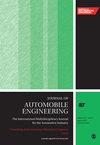基于模型预测控制和门控递归单元模型的车道偏离预防协同控制
IF 1.5
4区 工程技术
Q3 ENGINEERING, MECHANICAL
Proceedings of the Institution of Mechanical Engineers Part D-Journal of Automobile Engineering
Pub Date : 2024-07-26
DOI:10.1177/09544070241264589
引用次数: 0
摘要
人机冲突对驾驶安全有重大影响,给车道偏离预防(LDP)系统的设计带来了重大挑战。针对这一问题,本文提出了一种驾驶员智能车辆协同转向扭矩辅助控制策略。基于门控递归单元(GRU)的车道偏离决策模块用于预测车辆的横向偏离,并对基于模型预测控制(MPC)的辅助控制器的切换做出实时决策。接下来,MPC 车道保持和减少冲突 (MPC-LKCR) 控制器的扭矩与驾驶员扭矩之间的冲突性能被添加到 MPC 车道保持 (MPC-LK) 控制器的优化目标中,而车道保持性能则继续保留。这是因为设计了一个基于模糊模型的共享因子,能够根据驾驶员的意图调整 MPC-LKCR 控制器内的辅助扭矩。最后,经过 MPC-LKCR 控制器的整体优化,驾驶员扭矩和辅助扭矩叠加后的最终扭矩作用于转向柱,实现人机协同转向控制。收集了 52 名驾驶员的驾驶数据,对 GRU 模型进行离线训练。在不同的驾驶场景下对所提出的策略进行了模拟和分析,并在驾驶模拟器上完成了硬件在环实验以验证其有效性。硬件在环实验结果表明,MPC-LKCR 控制器与 MPC-LK 控制器相比,平均冲突强度和冲突时间比分别降低了 23.8% 和 34.4%。该策略不仅能完成车辆偏离车道的任务,还能有效减少人机冲突的时间和强度。本文章由计算机程序翻译,如有差异,请以英文原文为准。
Cooperative control for lane departure prevention based on model predictive control and gated recurrent unit model
Human-machine conflict has a significant impact on driving safety, posing a vital challenge in the design of lane departure prevention (LDP) systems. To address the issue, this paper proposes a driver-intelligent vehicle cooperative steering torque assistance control strategy. The lane departure decision-making module based on the gated recurrent unit (GRU) is used to predict the lateral deviation of the vehicle and to make real-time decisions regarding the switching of the model predictive control (MPC) based assistance controller. Next, the conflict performance between the MPC lane keeping and conflict reduction (MPC-LKCR) controller’s torque and the driver’s torque is added to the optimization objective of the MPC lane keeping (MPC-LK) controller, while the lane keeping performance is continually retained. That is because a shared factor based on the fuzzy model is designed with the ability to adjust the assistance torque within the MPC-LKCR controller according to the driver’s intention. Finally, after the overall optimization of the MPC-LKCR controller, the final torque after the superposition of driver and assistance torque acts on the steering column to realize the human-machine cooperative steering control. The driving data from 52 drivers were collected to train the GRU model offline. The proposed strategy was simulated and analyzed under different driving scenarios, and hardware-in-the-loop experiments were completed on a driving simulator to validate it. Hardware-in-the-loop results show that the average conflict intensity and conflict time ratio are reduced by 23.8% and 34.4% under the MPC-LKCR controller compared to the MPC-LK controller. The strategy not only accomplishes the task of vehicle lane departure but also effectively reduces the time and intensity of human-machine conflicts.
求助全文
通过发布文献求助,成功后即可免费获取论文全文。
去求助
来源期刊

CiteScore
4.40
自引率
17.60%
发文量
263
审稿时长
3.5 months
期刊介绍:
The Journal of Automobile Engineering is an established, high quality multi-disciplinary journal which publishes the very best peer-reviewed science and engineering in the field.
 求助内容:
求助内容: 应助结果提醒方式:
应助结果提醒方式:


